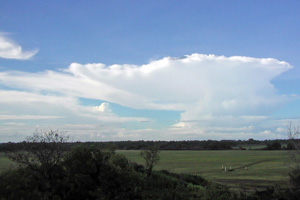ACTIVE Project-Scientific Objectives

The overall aim of this proposal is to determine the impact of deep convection on the composition of the TTL and its relative importance compared with large-scale ascent.
i. To relate measurements of aerosol and chemical species in the outflow of deep convection, and in the surrounding TTL, to low-level sources.
ii. To determine how deep convection modifies the aerosol population reaching the outflow, and thus evaluate its impact on cirrus nucleation in the TTL.
iii. To compare the concentration of aerosol and chemical tracers (with a range of lifetimes and origins) in the outflow with that in the background TTL, and therefore determine the contribution of convection to the composition of the TTL over Darwin.
iv. To use latitudinal surveys of tracers, together with high-resolution global models, to determine the contribution of large-scale transport to the composition of the TTL
v. To compare the effects of isolated very deep convection with that of widespread but less penetrative convection on the composition of the TTL.
vi. To determine the contribution of deep convection to the NOx and O3 budget in the TTL
vii. To measure how much black carbon reaches the outflow regions of the storms.